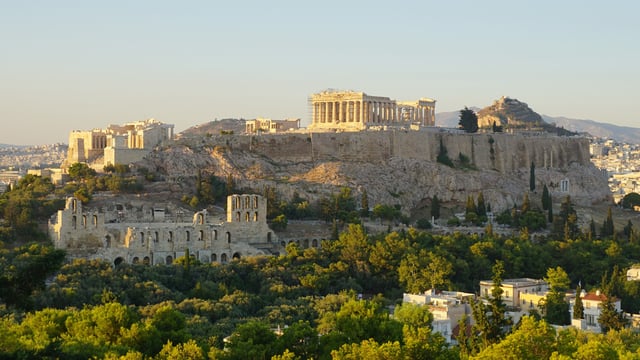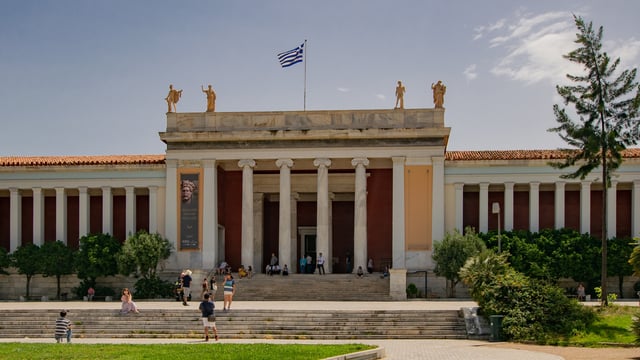Roman Sites & Museums in Athens
Roman Sites In Athens
Hadrian's Arch
Unlike many other comparable Roman arches, the Arch of Hadrian appears to be a much more slight and slender construction. A single arch spanned a road that would have lead back to the Acropolis. Two inscriptions on the architrave seem to suggest that the arch marked the boundary between old and new Athens. When in 1778 the Turkish governor Hadzi Ali Haseki built a wall to enclose the lower city, Hadrian’s Arch was incorporated as a gate in this wall. Unlike other monuments which were destroyed in this process.

Hadrian's Library
Built in 132 CE, the Library was a gift from Emperor Hadrian to the people of Athens. Hadrian was a committed Hellenophile, and he did much to leave his mark here. Today we enter the site at the imposing Pentelic marble façade, with its monumental Corinthian gateway. A small onsite exhibition room houses a colossal statue of Nike and some other artefacts recovered on the site.


Kerameikos Archaeological Site & Museum
A walkable distance from the main concentration of ancient sites north-west of the Acropolis is the oldest and largest ancient cemetery of Kerameikos. This was one of the largest districts of ancient Athens, and it was here that the potters who made the iconic ‘Attic vases’ lived and worked. Besides funerary features, you can also see part of the Themistoclean Wall, the Dipylon Gate and Sacred Gate. An onsite museum houses artefacts from the site, mostly dealing with funerary customs and rituals through the ages.


Olympieion - Temple of Olympian Zeus
Although the colossal Temple of Olympian Zeus can be seen from the street (it is one of the largest Classical temples), this is a monument that definitely should be experienced up close. When completed by Hadrian in the 2nd century CE 104 columns made up the temple. Of these, only 16 remain standing today. There are many other features on site, including a Roman bath house, a basilica and the remains of the city’s walls.


Roman Agora
The site of the Roman Agora, built between 19 and 11 BCE, was the first commercial centre of Athens. Here a large courtyard is surrounded by shops and other commercial buildings. Just beyond the agora, are the remains of the public toilets and the octagonal Tower of the Winds, built for astronomical purposes. The tower has carvings that depict the ‘eight winds’, and during the Ottoman period was used by Turkish Dervishes. In 1458 the Ottomans built the Fethiye Mosque on the site of a Byzantine basilica.


Stenopos Kollytos Archaeological Area
Walking along the road beyond the Odean of Herodes Atticus are the remains of the ancient municipality of Kollytos. In the 1890s archaeologists uncovered a 4 m wide road that ran between houses, workshops and shrines. The buildings date between the 4th century BCE and the 4th century CE. Although the remains are behind railings, there is an informative panel and the mosaic floor in the ‘House of the Roman Mosaic’ is clearly visible.

The Acropolis
Arguably one of the world’s most iconic archaeological sites, it is certainly the most popular in Athens. Although there is evidence of some 5,000 years of activity on the citadel, it is the ruins of ancient temples and sanctuaries, the most famous being the Parthenon, from the 5th century BCE to the Roman period that are highlighted, and the focus of restoration work. Anything post-Roman, including the Christian church and Ottoman mosque, has been all but obliterated, and this period of the Acropolis’ history receives only passing mention.


Museums with Roman Collections in Athens
Acropolis Museum
Opened in 2009, this award winning museum displays over 4,000 objects from the nearby Acropolis. These range from the Bronze Age to Roman and Byzantine periods on the citadel. One of the reasons for the construction of this state-of-the-art museum was the reunification of sculptures taken by Lord Elgin from the Parthenon. The museum was constructed above the archaeological site of Makrygianni. Visitors can follow walkways in a space under the museum to see in situ features of Roman and early Byzantine Athens.


Athens International Airport Museum
In the main terminal of the Athens International Airport there are three permanent exhibitions, free to visit. The first is an exhibition of the archaeology found during the construction of the airport in the Mesogaia area. On display are 172 archaeological artefacts from the Neolithic to the Post-Byzantine period. A small area with a few replicas and digital displays covers the Acropolis Museum. A third multimedia presentation explores Eleftherios Venizelos’ role in forming the modern Greek nation as well as its aviation ministry.

History Museum of the University of Athens
Founded in 1987, the museum presents a history of the University of Athens through a range of artefacts such as letters and manuscripts, photographs and scientific instruments, university seals and other memorabilia. Archives represent a range of disciplines, including law, medicine, archaeology, history and chemistry. The 18th century building that is home to the museum is one of the few surviving from pre Othonian times, making it one of the oldest residential buildings in Athens. Situated on the north slopes of the Acropolis, the building housed the first university of an independent Greek state that was inaugurated in 1837.

Museum of Cycladic Art
Established in 1986, the Museum of Cycladic Art houses Nicholas and Dolly Goulandris’ extensive collection of Cycladic and Ancient Greek art. The couple had been collecting prehistoric and ancient art since the 1960s. The museum also has one of the largest collections of Cypriot antiquities in the world outside of Cyprus. There are three permanent exhibitions: Cycladic art from the Cycladic Islands (3200 – 2000 BC), Greek art (2000 BC to 395 AD), and art from Cyprus (3900 BC to the 6th century BC).


Museum of Islamic Art (Benaki)
With objects from as far as India, Persia and Mesopotamia in the east, as well as Egypt and North Africa, and Spain in the west, the collections of Islamic art in the Benaki Museum makes this one of the most important Islamic art museums in the world. Housed in the historic Kerameikos district, the museum is close to important archaeological sites, including the Ancient Agora and Kerameikos. An ancient tomb and a section of the ancient city wall of Athens were uncovered during renovation work for the museum.

Museum of Paul and Alexandra Kanellopoulos
On the north slopes of the Acropolis is the Neoclassical Michaleas residence, built in 1894 and now home to one of the richest private collections of ancient artefacts. There are over 7,000 objects, ranging in date from the Neolithic period to the Post Byzantine era. The objects are displayed in chronological and thematic order. This was the private collection of Paul and Alexandra Canellopoulos that they donated to the Greek state in 1972 and opened to the public in 1976. In 2004 an extension was built so that the entire collection could be exhibited.

National Archaeological Museum of Athens
Greece’s National Archaeological Museum in Athens is home to some of the most well known artefacts from all over the modern nation state of Greece. From prehistory to the Romans, with special collections of Cypriot and Egyptian antiquities. The museum has been in the current building with its spectacular Neoclassical façade since the 1889, but has been expanded many times since then. With the richest collection of ancient Greek artefacts anywhere in the world, this is a must for anyone with an interest in ancient Greece.


War Museum
Built on the site of an old artillery camp and opened in 1975, the War Museum in Athens is the largest museum of military history in Greece. The aim is to collect, research and display artefacts and memorabilia relating to the history of conflict and warfare from antiquity to the recent past. A vast array of artefacts are displayed chronologically, from Stone Age obsidian weapons to weapons and artillery used in more recent battles. Besides weapons and uniforms, the museum also displays numerous maps and significant historic documents, including from the Latin and Ottoman occupation.


















